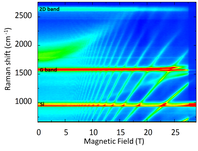Layered materials can realize different stackings of their individual planes, different polytypes, to compose three-dimensional structures.
ABA-stacked graphite is the most stable form of graphite at ambient conditions and the study of thin layers of this material have revealed many interesting phenomena related to the change of the nature of quasiparticles when adding layers one by one. Graphite can also exist in the so-called rhombohedral stacking or ABC-stacking, which is less abundant. As a result, studies of this polytype are today limited to its simplest form, the ABC trilayer. Tight-binding models show that a pair of electron bands at zero energy with flat dispersion develops when increasing the number of layers and that the wave functions associated with the flat bands are spatially located on the top and bottom surfaces while other gapped subbands are confined in the bulk of a crystal. This is in clear analogy with crystalline topological insulators. These flat bands are expected to host, yet unexplored, exotic electronic ground states.
We have successfully produced thick layers (~15 layers) of ABC-stacked graphite by mechanical exfoliation of bulk graphite and we have identified their Raman-scattering signatures. Applying a magnetic field perpendicular to the plane of our crystal, induces Landau quantization in the electronic system, a phenomenon directly observable in our magneto-Raman scattering spectra (Figure). Indeed, many magnetic-field-dependent Raman scattering peaks appear and these electronic excitations can be grouped into two families: one arising from the flat bands which evolve linearly with magnetic field, but with a negative energy intercept at B = 0, and another one with negative dispersion with magnetic field arising from the gapped subbands in the bulk. Besides showing that this material exists we have presented its (magneto-)Raman scattering signatures. This work serves as an impetus for further studies on gated structures in order to be able to tune the position of the Fermi level and to place it right in the middle of the flat band.
Rhombohedral Multilayer Graphene: A Magneto-Raman Scattering Study,
Y. Henni, H. P. Ojeda Collado, K. Nogajewski, M. R. Molas, G. Usaj, C. A. Balseiro, M. Orlita, M. Potemski, and C. Faugeras, NanoLetters 16, 3710 (2016).
Figure: False color map of the magneto-Raman scattering response of 15 ABC-stacked graphene layers showing electronic excitations within an electronic band with flat dispersion.








Leave A Comment
You must be logged in to post a comment.